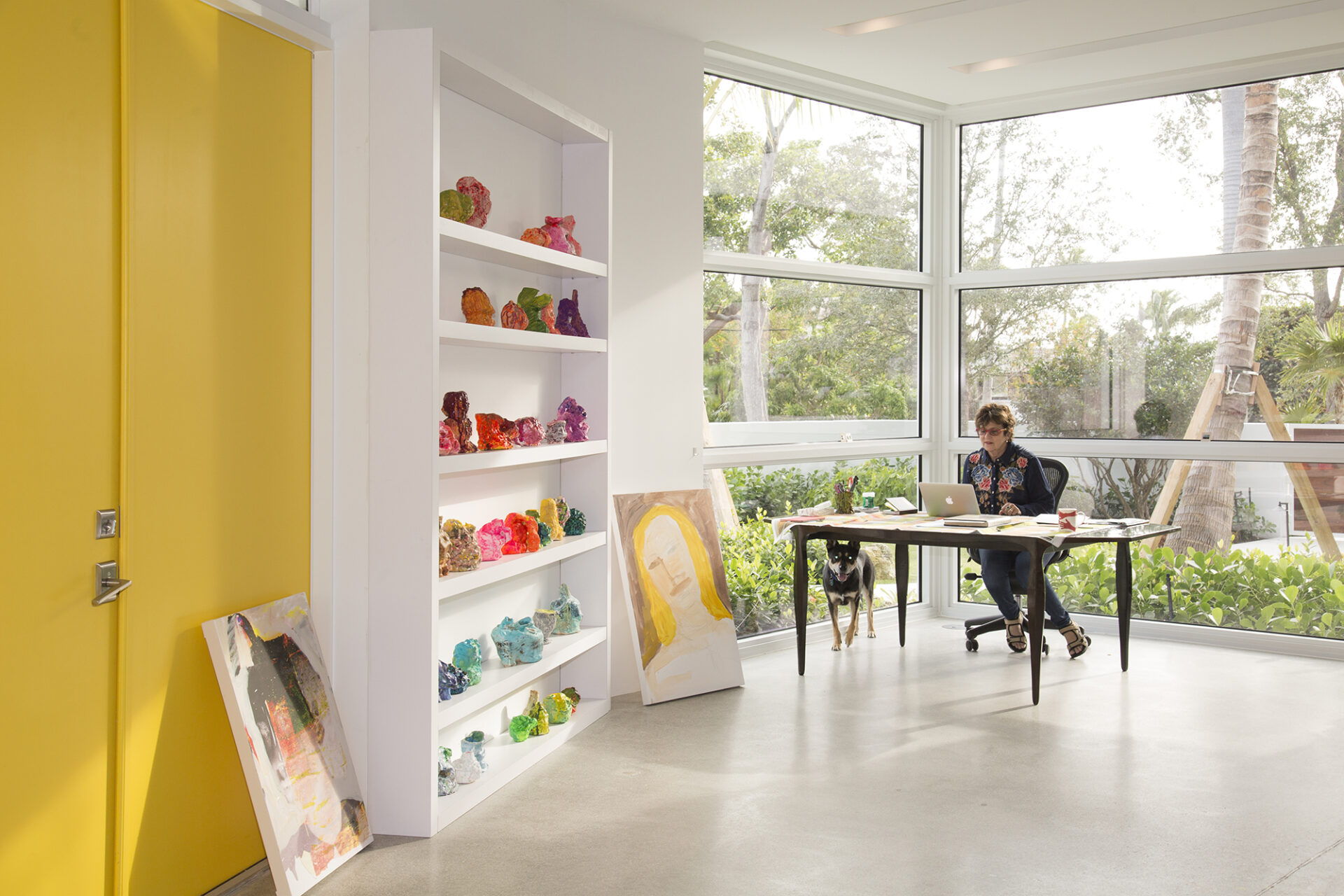By Robin Hodes
Photography by Robin Hill
Francie Bishop Good’s studio is her second home, and conveniently, it’s just steps away from her first.
Nicknamed “H.A.T.S.” (the “Home Across the Street”), the modern, sundrenched structure houses not only her art studio but also four guest rooms—each decorated to represent one of the four seasons—to accommodate visits from her ever-growing extended family. The studio also showcases a remarkable art collection that combines works by Bishop Good and other artists she and her husband, David Horvitz, admire. H.A.T.S. is indeed situated right across from the couple’s primary residence in Fort Lauderdale (they also maintain homes in Colorado and New York). When inspiration strikes, Bishop Good can start creating in an instant. “I can crawl out of bed in the morning, grab a cup of coffee and cross the
street,” she says. “It’s incredible.”
Bishop Good and Horvitz have made extraordinary contributions to the art world, especially in South Florida. They are leading collectors, major donors and passionate advocates who have been members of the NSU Art Museum Fort Lauderdale’s board of governors since 2007, with Horvitz serving as chairman for six years. Bishop Good is a two-time recipient of the South Florida Cultural Consortium Fellowship and the State of Florida Individual Artist Fellowship, and her work has been exhibited nationally and internationally.
In 2013, the David and Francie Horvitz Family Foundation presented the NSU Art Museum with a $1.5 million challenge grant that has since been fulfilled, and three years later, the museum received a second challenge grant from the foundation: $1 million to support exhibitions, programming and operations. The goal for the match was achieved just nine months after the announcement.
Recently, the couple also made a promised gift of 100 works, primarily consisting of pieces by female artists, from their collection of contemporary art. A portion of the gift has already been deeded to the museum, and more works will come each year.
Bishop Good and her husband are also credited with creating Girls’ Club, a private foundation and alternative space in Fort Lauderdale established in 2006 to educate the public, nurture the careers of female artists and serve as a resource for students, scholars, curators and artists to embrace the contributions of women to the field of contemporary art.
For Bishop Good, this emphasis on girl power seemed like a natural calling. “One day about 20 years ago, I looked around our house and realized 90 percent of the work we acquired was by women,” she says. “It just happened organically.” The collection has since grown to more than 800 works.

The east elevation of H.A.T.S. showcases contemporary architecture. The main structure is fashioned by stucco, but the tongue-and-groove wood detailing on the underside of the roof and porcelain enhancements at the front entry generate added interest. The surrounding foliage offers privacy, and the glass-railed balcony is Bishop Good’s preferred “thinking place.”
As a 7-year-old living in Allentown, Pennsylvania, taking pictures with her first camera, Bishop Good suspected art would eventually become her life. She majored in painting and photography at the Philadelphia College of Art, eventually earning a bachelor’s degree in fine arts from the University of Colorado Boulder in 1972. Her career has included teaching art to students from preschool to college, and after meeting Horvitz, with whom she began to collect contemporary art, Bishop Good started her studio practice.
Much like Bishop Good’s art, H.A.T.S. is layered, textured and evocative. She enlisted Fort Lauderdale-based architect Robert Tuthill, who she describes as “sweet, flexible and very talented,” to design a refreshingly modern edifice, a complete departure from the couple’s former Mediterranean-style home. Tuthill fulfilled the artist’s vision by incorporating expansive windows for an inflow of natural light, plenty of space for guests and a sizable studio with room for a kiln.
Bishop Good tackled the interior. Considering her series of vivid paintings and clay sculptures (“Pairings”) and her mixed-media portraits (“Comus”), she infused the eclectic décor with a kaleidoscope of color. The palette is a veritable Pantone chart—a juicy orange sofa here, a sunny yellow door there, oceanic turquoise bedding, lipstick-red floors—all set against a soothing white canvas. Any hue not represented in the furnishings, paint, accessories or tile details can be found in the multitude of art that adorns the walls and lines the shelves. Naturally, the assemblage is carefully thought out. “Hanging art and displaying sculpture is just like the making of an artwork,” Bishop Good says. “It takes time, doesn’t always work out as planned and can be changed.”

The dining area features a vintage table and contrast seating. Two curvaceous ebony chairs designed by Tucker Robbins represent the human figure alongside a pair of Konstantin Grcic industrial stacking chairs in white aluminum. A Isamu Noguchi rice paper fixture radiates ambient light, and the space is completed by Bishop Good’s artwork.
This article originally appeared in the Fall 2018 Issue.




